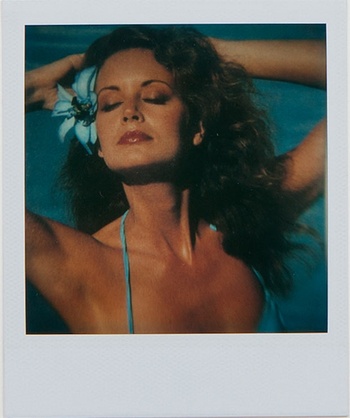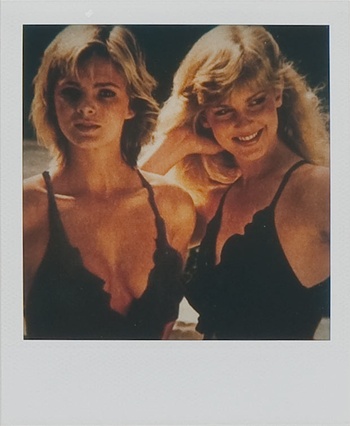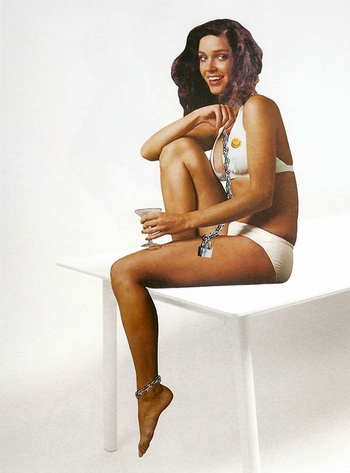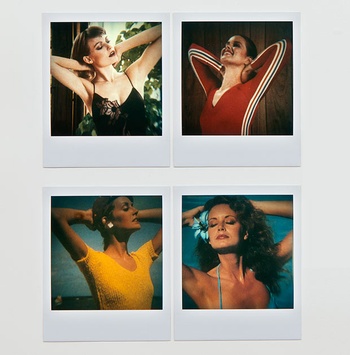(© Robert Heinecken, Courtesy The Robert Heinecken Trust)
The US conceptual artist Robert Heinecken was denounced in the late 1970s as a sexist, even though he was actually trying to mock the hypocrisy underlying the suggestive poses of the girls in photographs in mail order catalogues. His recycling art is currently experiencing a revival, with a retrospective at the MoMA and a new exhibition of his Polaroid snaps in Wiels.
The general public doesn’t really know Robert Heinecken (1931–2006) – as even the current Wiels show demonstrates. His Polaroid art is hidden away upstairs, behind an exhibition of work by Allen Ruppersberg, who like Heinecken is from Los Angeles and was born about ten years after him, according to Devrim Bayar, the curator of both exhibitions. “But even he had never heard of him! One of the main reasons why he didn’t even make an impact in artistic circles is that, as founder of the photography department at the UCLA university in Los Angeles and a teacher there, he mainly concentrated on photography. It was only much later that people began to make connections between his work and the wider field of contemporary art.”
The major retrospective currently to be seen at the Museum of Modern Art (MoMA) in New York illustrates that re-evaluation. “In our exhibition, which focuses specifically on Heinecken’s work with the Polaroid SX-70, we make connections with other artists who belong to the ‘Pictures Generation’, like Richard Prince. It was in the spirit of the times to reuse images that had already been circulated by the mass media.”
Robert Heinecken: sexy or sexist?



Heinecken saw himself as a “paraphotographer”, because he hardly ever picked up a camera himself. In fact, he only did so at the beginning of his career, when his second wife, Joyce Neimanas, introduced him to the Polaroid SX-70. “You could call it a precursor of the iPhone,” says Bayar. “It was the first camera with which you could photograph whatever you wanted in complete privacy. It was not just the general public that was wild about it: lots of artists were too, including Andy Warhol. Initially, he used the camera to record intimate things: he took unabashed photographs of his wife, of her feet, but also of her nipples and of his own genitals. It was not for nothing that the SX-70 was called the ‘bedroom camera’.”
But even Heinecken’s earliest Polaroid photographs, which open the exhibition, are not purely autobiographical. Under or alongside each picture is a piece of text, a popular format indebted to the then emerging Narrative Art movement. In this case, what we read is a handwritten dialogue between a man and a woman, in which the power relations between the two sexes are often expressed in acerbic, sarcastic terms. “Later, in the He/She (1980) book of photographs, he would replace those personal photographs with images of stereotypical couples that he found in magazines and re-photographed with his SX-70, which gave them a realistic touch, even though there was nothing instant or spontaneous about them.”
Which brings us to Lessons in Posing Subjects, the showpiece of the exhibition of the same name. Ten sets of prints were made, but only two sets have survived intact; the full series can be seen at Wiels. “By re-photographing cuttings from fashion magazines with an SX-70, he made the pictures more uniform, but the attractiveness of the original advertising material is preserved. The aim of these pictures was to seduce, and they still do that. I can see that, whenever flyers for the exhibition are distributed. People find their aesthetic immediately appealing.” And that despite the fact that everything in the pictures is artificial: the way the models pose, the sets, the framing… So they become a caustic critique of the deceitful mass media. The fictional texts accompanying these “fake lessons” add an extra satirical touch. “Heinecken sometimes made a game of it. Once, he asked the viewer to guess which smile belonged to which model.”
Although clearly intended as a criticism of the representation of the female body in the mass media, his work was heavily criticised. “In the late 1970s, a number of female artists accused him of misogyny,” recalls Bayar, who says that this is one of the reasons why people were unwilling to exhibit his work at the time. “I have been told, too, that Heinecken was a real womaniser. That may also have been a factor.”
But even Heinecken’s earliest Polaroid photographs, which open the exhibition, are not purely autobiographical. Under or alongside each picture is a piece of text, a popular format indebted to the then emerging Narrative Art movement. In this case, what we read is a handwritten dialogue between a man and a woman, in which the power relations between the two sexes are often expressed in acerbic, sarcastic terms. “Later, in the He/She (1980) book of photographs, he would replace those personal photographs with images of stereotypical couples that he found in magazines and re-photographed with his SX-70, which gave them a realistic touch, even though there was nothing instant or spontaneous about them.”
Which brings us to Lessons in Posing Subjects, the showpiece of the exhibition of the same name. Ten sets of prints were made, but only two sets have survived intact; the full series can be seen at Wiels. “By re-photographing cuttings from fashion magazines with an SX-70, he made the pictures more uniform, but the attractiveness of the original advertising material is preserved. The aim of these pictures was to seduce, and they still do that. I can see that, whenever flyers for the exhibition are distributed. People find their aesthetic immediately appealing.” And that despite the fact that everything in the pictures is artificial: the way the models pose, the sets, the framing… So they become a caustic critique of the deceitful mass media. The fictional texts accompanying these “fake lessons” add an extra satirical touch. “Heinecken sometimes made a game of it. Once, he asked the viewer to guess which smile belonged to which model.”
Although clearly intended as a criticism of the representation of the female body in the mass media, his work was heavily criticised. “In the late 1970s, a number of female artists accused him of misogyny,” recalls Bayar, who says that this is one of the reasons why people were unwilling to exhibit his work at the time. “I have been told, too, that Heinecken was a real womaniser. That may also have been a factor.”

The guerrilla work Heinecken was engaged in back then is now more likely to bring a smile to people’s faces. “Every now and then, he bought a pile of magazines and went to work on them. So the naked ladies from Penthouse found their way into Time and Life and then he put the magazines back on the stands in shops.” The cuttings with naked female genitalia usually fetched up on the knickers that the models in advertising photographs were actually wearing, although their suggestive poses insinuated that they weren’t. Heinecken was a master of that kind of decontextualisation. He wanted to expose the hypocrisy of the mass media. By being so “in your face”, he may have stymied his own career, but on the other hand it means that he is still relevant today.
“Even though today’s clothes and models look quite different, the suggestive poses of women in advertising haven’t really changed much,” observes Bayar. “It may be that these days everyone immediately puts their photographs on Instagram or Facebook, but it is still mediated, so the question remains: what is real and what is fake? That is the central question in Heinecken’s oeuvre. During the first class of the academic year, he always brought some plastic objects along. Asked what they represented, his students answered, for example, ‘an egg on a plate’, at which he would say: ‘What you see is not what you see.’”
Robert Heinecken: Lessons in Posing Subjects • 16/5 > 17/8, wo/me/We > zo/di/Su 11 > 18.00, €8, WIELS, avenue Van Volxemlaan 354, Vorst/Forest, 02-340.00.53, www.wiels.org
“Even though today’s clothes and models look quite different, the suggestive poses of women in advertising haven’t really changed much,” observes Bayar. “It may be that these days everyone immediately puts their photographs on Instagram or Facebook, but it is still mediated, so the question remains: what is real and what is fake? That is the central question in Heinecken’s oeuvre. During the first class of the academic year, he always brought some plastic objects along. Asked what they represented, his students answered, for example, ‘an egg on a plate’, at which he would say: ‘What you see is not what you see.’”
Robert Heinecken: Lessons in Posing Subjects • 16/5 > 17/8, wo/me/We > zo/di/Su 11 > 18.00, €8, WIELS, avenue Van Volxemlaan 354, Vorst/Forest, 02-340.00.53, www.wiels.org
Read more about: Expo
Fijn dat je wil reageren. Wie reageert, gaat akkoord met onze huisregels. Hoe reageren via Disqus? Een woordje uitleg.